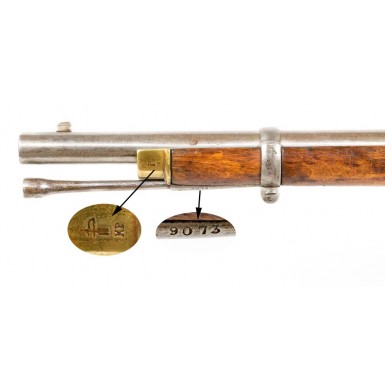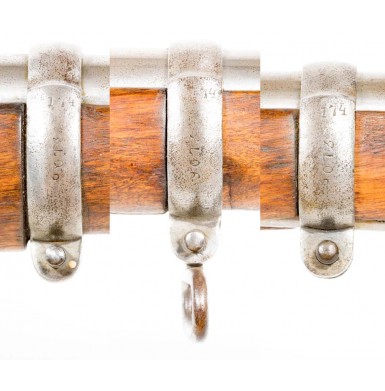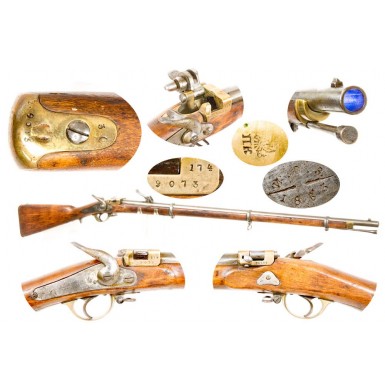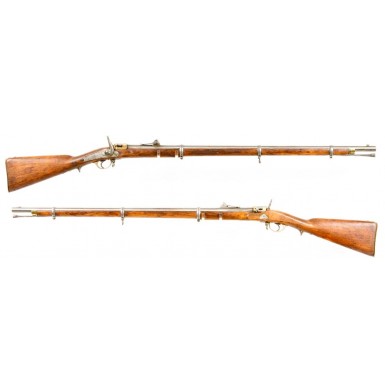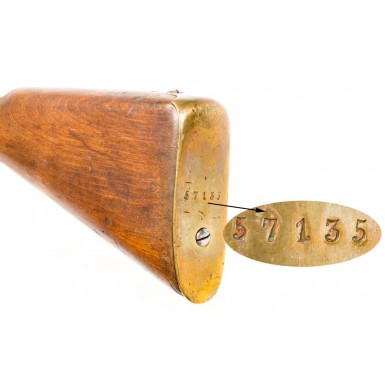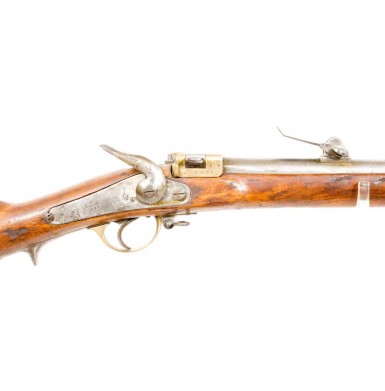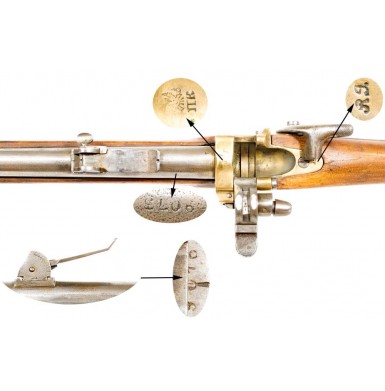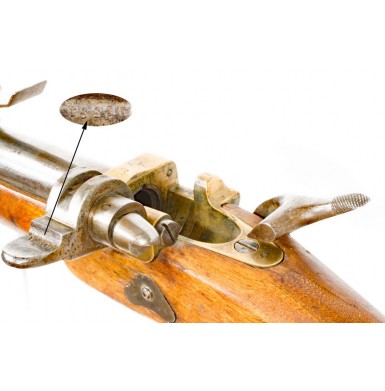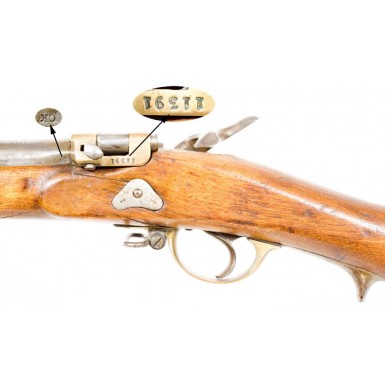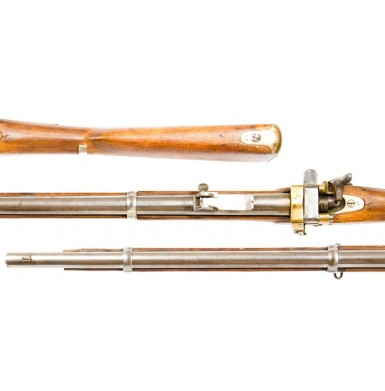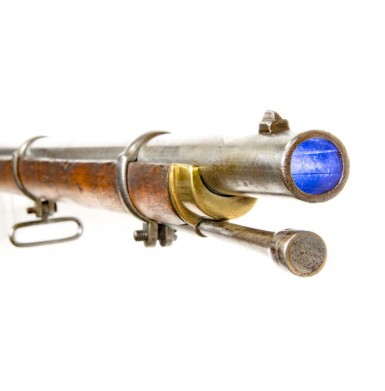Exceptionally Rare Russian M1856/67 Krnka Rifle
- Product Code: FLA-3505-SOLD
- Availability: In Stock
-
$1.00
In 1839, the Russian military adopted the percussion ignition system and by the early 1840s had undertaken a percussioning program similar to those in the United States and most of the European nations to alter existing stocks of flintlock muskets and rifles to percussion. In 1845, the Russians adopted a new percussion musket, officially leaving the flintlock system behind. Like the earlier Russian M1828 and M1839 flintlock muskets, the new percussion M1845 drew heavily on French influences and bore a strong resemblance to the French M1842 Musket, down to the adoption of the back action lock, foregoing the forward action lock that remained standard in the United States, Great Britain and most of Europe, with the exceptions of France and Belgium. Like the earlier flintlock muskets, the M1845 was a large bore (nominally .71 caliber) smoothbore, single shot muzzleloading long arm.
In October of 1853, the Crimean War erupted, pitting the Ottoman Empire and their allies the British, French and Sardinians against the Czarist Russian Empire and their small contingent of allies, including Bulgarian volunteers, the Principality of Mingrelia and for a short time the Kingdom of Greece. With the British entry into the war, the Russians soon found out that their conscript infantry was woefully under armed with their large caliber smoothbore percussion and percussion conversion muskets. The British had adopted rifled arms for general issue to all line infantry regiments in 1851 with the Pattern 1851 Mini” Rifle, and at the same time had taken their first steps towards a smaller bore weapon, as the .708” Mini” Rifle was smaller in caliber than the earlier Pattern 1839 and Pattern 1842 .75 caliber British muskets. However, the real trump card of the English was their newly adopted Pattern 1853 Enfield Rifle musket, a reduced caliber .577” bore long arm with three-groove rifling and an adjustable 900-yard backsight. The superiority of the new “Enfield” versus the Russian muskets was immediately obvious. The Crimean War ended in March of 1856, but the lessons learned by the Russians from the English would affect Russian small arms design for the next two-decades.
In 1854, the Russians started rifling and sighting existing stocks of M1845 muskets, but this was “too little too late” and few of the rifled arms reached the troops in the Crimea before the end of the war. It was also clear that a new reduced caliber design was the wave of the future. In 1856, the Russians adopted their first rifled long arm of reduced bore for general issue to the infantry, the Model 1856 or Six Line Rifle. The nickname was derived from the caliber of the gun and the Russian unit of measure, the liniya, which was 1/10 of a diuym. A diuym had been established as being equal to an English inch by Peter the Great, thus a liniya was 1/10”, and six liniya was 6/10” or .60 caliber. The new design retained the French-style back action lock of the earlier M1845 muskets, which was retained by a single lock screw that passed through the front of the lock, screwing into a rounded triangular escutcheon on the counterpane and by a single spanner screw at the tail of the lock. However, the new design introduced a very English stock profile with a brass nose cap and clamping barrel bands, all of which were certainly a tip of the Russian ushanka (fur cap) to the English Enfield. The ramrod of the new Six Line Rifle Musket was swelled with a profile that was similar to the Austrian M1854 Lorenz rifle musket ramrod, with a tulip shaped head that included a torque hole, very much like its Austrian counterpart. The rear sight was a distinctive feature, as it was a Swiss-style pivoting leaf of the same pattern that had been used on the Li’ge-made Russian M1843 Luttich Carbines, which were Belgian-made Russian contract copies of the British Brunswick Rifle. This same pattern of rear sight had also been specified when the Russians placed a large order for percussion altered rifled-muskets from Colt during the Crimean War. The new M1856 Rifle Musket was 53” in overall length with a 37” long, .60 caliber barrel that was rifled with four grooves with a relatively slow rate of twist of about 1:49”, or “ of a turn in the length of the barrel. The buttplate, nose cap and triggerguard were of brass, with all of the other furniture of iron, including the triggerguard plate and its extended finger rest. A combination musket-style front sight and bayonet lug was located on the top of the barrel, slightly less than 1” from the muzzle, allowing the mounting of a traditional angular socket bayonet. The stock was of stained birch with a grain pattern similar to Austrian and Prussian beech. The Six Line percussion rifle musket remained the mainstay of the Russian infantry for a decade.
Like the rest of the world, the Russian watched the carnage of the American Civil War with some interest and with an eye towards evaluating the practicality of new small arms designs for future conflicts. The most obvious lesson of the American Civil War was that the percussion muzzleloading musket was obsolete and that breechloading metallic cartridge arms were the new standard on the modern battlefield. The Russians found themselves in the same quandary as the rest of the major powers, how best to adapt the huge stocks of existing muzzleloading percussion long arms to breechloading cartridge guns. In America, the solution was Erskine Allin’s “Trapdoor” system, in England it was the “Snider” conversion and in France it was the “Tabati’re”. All of which were essentially similar hinged breech alterations that allowed muzzleloading percussion arms to be converted to breechloading metallic cartridge guns. The Russians looked at the various systems that had been adopted, and were in development, and chose a hinged breech alteration based upon the design of Czech arms designer Sylvester Krnka. With that choice, the term “Krnka” would forever be associated with cartridge altered Russian muskets, just as “Trapdoor” and “Snider” are associated with the arms of the United States and Great Britain during the late 1860s and through the 1870s.
Krnka’s system was very simple and is quite similar to both the English Snider and French Tabati’re alterations. The original breech was removed from the barrel and a new bronze breech piece was added with the barrel screwed into it. The breech was opened by pivoting a steel block to the left. This block contained the simple firing pin, as well as external piece that communicated the impact of the hammer to the pin. The rear of the external striker was machined flat so that the modified hammer nose would engage the flat section and keep the breech block from opening at an inopportune time. The 90-degree hammer nose engaged this piece at both the half-cock and the fired position to keep the breech closed, requiring the gun to be placed on full-cock in order to load or unload it. A rudimentary pivoting extractor was incorporated into the left side of the breech mechanism and was engaged when the breech block was pivoted fully to the left, applying enough pressure to pull the rim of the cartridge out of the chamber; hopefully. The altered arms were chambered for the 15.24x40R, a .60 caliber, rimmed centerfire cartridge, similar to the French Tabati’re in terms of its stubby appearance and relatively puny ballistics when compared to the US .50-70 or British .577 Snider. As the Russian arms of the period were not fully interchangeable, assembly numbers were stamped throughout the guns. On the Krnka alterations a combination of assembly mating numbers is typically encountered, both from the original percussion assembly and from the alteration process. To further confuse things, the guns were serial numbered on their buttplates when they were originally manufactured, and the Krnka breeches were also serial numbered when they were produced. Thus, a standard Krnka alteration will bear the serial number of the percussion gun on its butt, the serial number of the breech on both the bronze and steel components and a conversion assembly mating number on many of the parts. As parts were sometimes mixed during the reassembly process, it is not uncommon to find mixed Russian arsenal marks on various components that now have matching conversion assembly numbers. The stocks of the Krnka alterations will typically have two cartouches as well, one from the original percussion assembly and one from the alteration.
Like most of the other cartridge alterations to military rifles during the late 1860s and early 1870s, the Krnka was a stop gap solution until a better system could be adopted. In 1870, the Russians adopted the Colt manufactured single-shot Model 1868 breechloading rifle, which had been invented by Hiram Berdan of the Berdan Sharpshooters of American Civil War fame. The rifle is known most often as the “Berdan I”. Very quickly thereafter the Russians adopted the M1870 “Berdan II” bolt action rifle. These would be the mainstay of the Russian military until the adoption of the Model 1891 Mosin-Nagant Rifle. Despite the adoption of improved technology, the Russian Krnka alterations remained in service for several decades after they were obsolete. They saw service during the Russo-Turkish War of 1877-1878, the Balkan Wars of 1912-1913 and even saw limited service with reserve troops as late as World War I. In addition to being used by the Russian Empire, the Krnka saw service with the Kingdoms of Bulgaria, Serbia and Montenegro, primarily as arms provided by Russia to those kingdoms during the Balkan Wars. Today, all 19th century Russian military arms are extremely scarce, as two World Wars saw most obsolete arms destroyed in scrap drives to create more modern munitions. The Krnka is an important part in the story of Russian military arms as it provides a stopping point for the collector of Russian flint and percussion arms and a starting point for the collector of Russian cartridge arms. Over the last decade I have only had the opportunity to offer a handful of 19th century Russian arms for sale and this is one of the more intriguing ones that I have ever had the opportunity to sell.
The Russian M1856/67 Krnka offered here is in about VERY GOOD condition, particularly for a 19th century Russian military long arm. While collectors often joke about the hard use seen by surviving Confederate long arms by referring to rough condition guns as “Confederate Fine” , the abuse those guns suffered was nothing compared to the exceptionally poor treatment that a Russian rifle would often receive in the hands of a Czarist-era peasant conscript! The gun is marked with a plethora of pre-revolutionary Cyrillic orthography and markings, as well as a dizzying array of serial and mating numbers. The lock is marked with initials . . . that represent 652A:89 @C659=K9 02>4, or the Izhevesk Arms Factory, over the manufacturing date of 1863. During the mid-19th century the Izhevesk arsenal emerged as the premier Russian arms manufactory and by the second half of that century was producing the finest quality arms in the empire. The top of the buttplate and the top of the Krnka breech are marked with the two-headed Russian Eagle along with various other small marks. The buttplate of the gun is stamped on the bottom with the serial number 57135, which was the original percussion musket serial number. The breech block is marked with the serial number 11391 on the left side and on the interior of the swinging breech door. This number was only the serial number of the breech assembly. The right side of the breech block is numbered with the conversion number 9073. This same assembly mating number from the alteration process appears on the top of the buttplate, on the top of the barrel, inside the lock, inside the barrel channel of the stock, on the right side of all three barrel bands, on the long range sight base and on the cleaning rod (ramrod). The right side of the breech block is also stamped 174. This sub-assembly number appears on the bottom of the barrel and on the right side of all of the barrel bands as well. The barrel bands were originally from a M1856 musket whose serial number ended with 9286 and the left side of the bands are all stamped with that number, as well as with the bow & arrow logo of the Sestroretsk arsenal where those components and the nose cap were produced. A variety of small Cyrillic characters, the marks of workmen and inspectors are found throughout the gun. The obverse butt is stamped with two illegible cartouches, the weakest likely the original percussion production cartouche and the slightly more legible one the mark applied after the alteration.
As noted the M1856/67 Rifle remains in VERY GOOD condition. The gun appears complete and remains mechanically functional. The original Swiss Federal Rifle pattern rear sight, graduated to 1,200 paces remains in place and is fully functional, and what appears to be the original sling swivels are present on the front bow of the triggerguard and the middle barrel band. The original cleaning rod/ramrod remains in place, numbered with the matching conversion assembly number. It is full-length and fully threaded at the end. The action of the rifle remains in crisp, fully functional condition with all of the various pieces of the mechanism appearing to function correctly. The metal of the gun has been lightly cleaned, weakening some of the markings, although they remain mostly legible throughout. The metal shows even pinpricking and light pitting over most of the iron and steel surfaces, and the barrel and bands have a medium pewter gray patina with a thinly oxidized layer of brownish patina over this gray color along with a few patches of scattered oxidized discoloration. The bore of the rifle remains in VERY GOOD condition as well. It retains strong rifling and shows scattered light pitting and some frosting along its length. The brass furniture has a deep golden color that is quite attractive. The stock shows the most wear and tear, having been lightly sanded and leaving the two cartouches only shadows of their former selves. The stock shows several grain cracks, including a pair that run through the bottom of the action diagonally, emanating from the triggerguard area, a diagonal crack along the counterpane and a tight grain crack behind the breech tang. All appear solid and unlikely to worsen with normal handling and storage but would likely worsen with rough treatment or under the stress of recoil if the gun was to be shot. It might be worth investing in some injected glue stabilization at some point to keep the gun from deteriorating in the future. For the time being, however, the stock appears to be solid, despite the cracks. The stock shows some scattered bumps, dings and handling marks; all typical of a military long arm, as well as some minor slivering along the forend and ramrod channel. The photos should do a good job of depicting the condition of the stock.
Overall this is a solid, complete and attractive example of an extremely rare Russian Model 1856/67 Krnka Rifle. These guns are scarce in Russia and are practically never seen for sale in America. In fact, the only example that I could find for sale recently is not in materially better condition but is priced $1,000 higher than this gun! This is one of the scarcest guns that I have had the pleasure to offer for sale and a particularly intriguing example of a mid-19th century cartridge alteration of a Russian percussion musket. For any collector who specializes in the Russian long arms of the cartridge period, this is the gun that you must have as the initial example in the collection. For the collector of Russian muzzleloading muskets, this is the final example chronologically for your collection. I don’t know when you will find another complete, matching numbered example for sale again, and for such a reasonable price, so don’t miss your chance to add this rare Russian rifle to your collection.
SOLD



